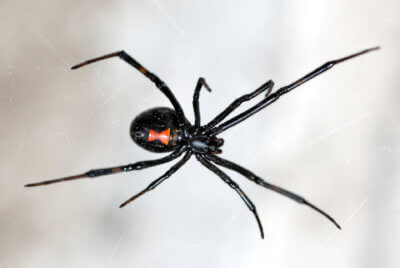Black Widow Spider Facts & Information
Everything you need to know about black widow spiders
What Do Black Widow Spiders Look Like

Black widow spiders are typically black with two reddish triangular markings usually joined to form a reddish hourglass shape on the underside of their abdomen – their most recognized feature. Females are occasionally brownish black. Most black widow spiders are 3 to 10 mm long, with females being larger than males. Black widow spiders have eight legs and eight simple eyes, including two lateral pairs that almost touch.
Young black widow spiders are primarily orange and white and acquire more black color as they mature. They have markings that are very similar to male adults – with one or two reddish markings on the underneath side of abdomen. One of the most obvious signs of almost any spider infestation is the presence of webs. Black widow spiders usually construct messy and irregular webs located near ground level. Finding a silken sac – which holds eggs – in the doorway is another sign that a spider infestation is underway. If you see any of these signs, professional black widow spider extermination services may be necessary. Most black widows take nearly a year to grow from egg to adult. They overwinter as immature individuals, develop into adults in the spring and die in late July. Female black widows have been known to consume male black widows once mating is complete, but contrary to popular belief, this doesn’t happen 100 percent of the time.Not the spider you have?
Young black widow spiders are primarily orange and white and acquire more black color as they mature. They have markings that are very similar to male adults – with one or two reddish markings on the underneath side of abdomen. One of the most obvious signs of almost any spider infestation is the presence of webs. Black widow spiders usually construct messy and irregular webs located near ground level. Finding a silken sac – which holds eggs – in the doorway is another sign that a spider infestation is underway. If you see any of these signs, professional black widow spider extermination services may be necessary. Most black widows take nearly a year to grow from egg to adult. They overwinter as immature individuals, develop into adults in the spring and die in late July. Female black widows have been known to consume male black widows once mating is complete, but contrary to popular belief, this doesn’t happen 100 percent of the time.Not the spider you have?
Where Do Black Widow Spiders Live
Black widow spiders favor dry, dark locations to spin their webs. They often seek out warm areas during the winter months. Outdoors, black widow spiders commonly live in protected areas. Those areas include under stones and decks, as well as in firewood piles and hollow tree stumps. The preferred habitats of black widows are dry man-made structures including barns, outhouses, henhouses, sheds, meter boxes, brick veneer, barrels, and woodpiles. Indoors, black widow spiders tend to hide in sheltered, dimly lit locations and are often found in garages, basements, and in crawl spaces. They prefer cluttered areas that offer more harborage for their prey.
Black widows are active when the temperature is 70 degrees or higher, but they can survive in lower temperatures with the right conditions. Black widow spiders spin irregular webs, which they build at night near ground level. Once complete, these spiders hang upside-down in their webs, which are usually less than 1 foot in diameter. They use their webs to ensnare prey. Similar to most spiders, black widows choose arthropods as their source of food, including ants, beetles, cockroaches, scorpions, and more.
Black widows are active when the temperature is 70 degrees or higher, but they can survive in lower temperatures with the right conditions. Black widow spiders spin irregular webs, which they build at night near ground level. Once complete, these spiders hang upside-down in their webs, which are usually less than 1 foot in diameter. They use their webs to ensnare prey. Similar to most spiders, black widows choose arthropods as their source of food, including ants, beetles, cockroaches, scorpions, and more.
How Did I Get Black Widow Spiders
As with most spiders, it’s difficult to keep them out completely. They can come in on deliveries, on your backpack, and even in a bag of groceries. Having a pest control professional come in to perform exclusion work like caulking to fill gaps and cracks and repairing screens can help. Also, since they like cluttered spaces, remove that attractant! Get rid of cardboard boxes and do some organizing. Not only will it help with spiders, but it will help with many other pests with the added benefit of being organized! Keep in mind that spiders are mostly beneficial since they help with many other pest populations. But if you see spiders in your home, that means you have other pests for them to feed on. Spiders don’t go where there is no food! So, a year-round general pest control program at your Massachusetts, Connecticut, New York, Maine, Vermont, New Hampshire, or Rhode Island home or business is the best way to take care of spiders. It will not only deal with black widow spiders, but the other pests they are eating.
What Problems Do Black Widow Spiders Cause
While male black widow spiders rarely bite, females may bite in defense, especially after laying eggs. Symptoms of a black widow spider bite include fever, increased blood pressure, sweating, and nausea. Pain is usually almost immediate and reaches its maximum in 1-3 hours. The pain associated with a black widow spider bite may continue for one to three days and then gradually subside. Fatalities from a black widow spider bite are unlikely, as long as proper medical treatment is sought in a timely manner. If you notice black widows or think you have been bitten, contact your doctor right away.
How Can I Prevent Black Widow Spiders
Professional exclusion work can help keep all pests out, including black widow spiders. Unfortunately, most pests are small, so keeping them out can be difficult. They can scuttle in while you’re bringing the groceries in or if a door is propped open too long. And it doesn’t need to be open for all that long! Once they are in, glue traps can help capture them. But preventing spiders from getting in could be a losing battle. You can minimize with exclusion work and some common sense practices, but to truly take care of all spiders – including black widows – you’ll need a pest control professional.
Why Waltham for Black Widow Spider Control
We’re passionate about controlling spiders because we live and work here – it’s our neighborhood, too. With our 130 years of experience keeping homes and businesses in Massachusetts, Connecticut, New York, Maine, Vermont, New Hampshire, and Rhode Island safe from pests, Western has the experience you can trust.
Satisfaction Guarantee
24-Hour Guaranteed Response
Board Certified Entomologists
Say goodbye to black widow spiders.
GET MY QUOTE
“Exceptional service. Prompt and professional. Used for both business and home. Very efficient and honest.”
Agawan, MA
